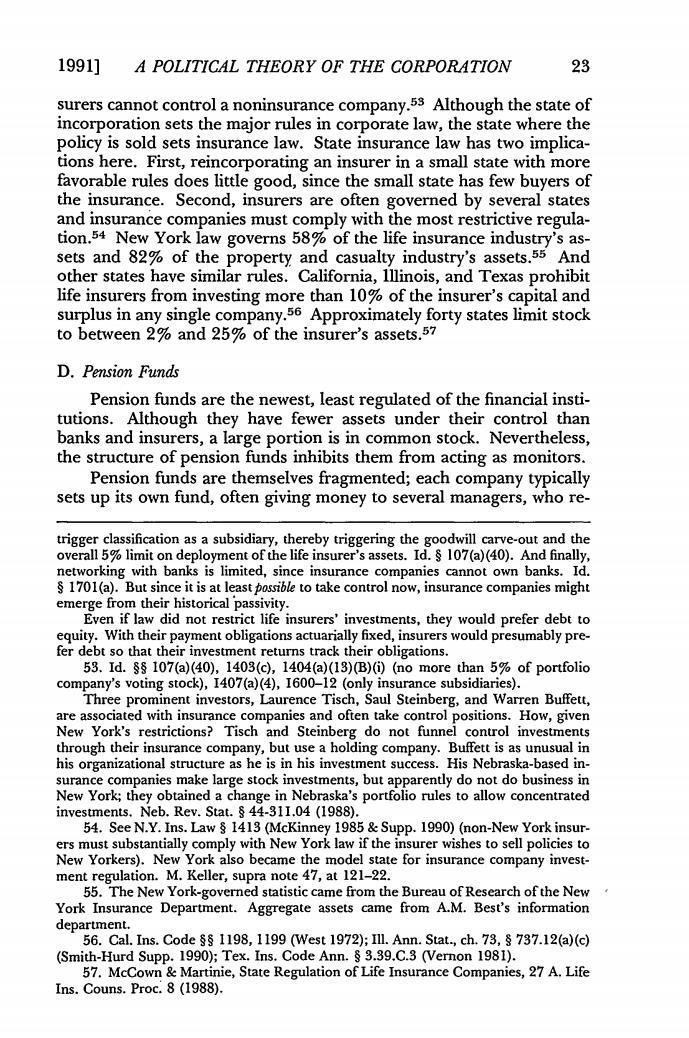正在加载图片...

19911 A POLITICAL THEORY OF THE CORPORATION 23 surers cannot control a noninsurance company.53 Although the state of incorporation sets the major rules in corporate law,the state where the policy is sold sets insurance law.State insurance law has two implica- tions here.First,reincorporating an insurer in a small state with more favorable rules does little of the good,s e insurance. Second, insurers are e oft n governed by severa and insurance companies must comply with the most restrictive regula tion.54 New York law governs 58%of the life insurance industry's as- sets and 82%of the property and casualty industry's assets.55 And other states have similar rules.California,Illinois,and Texas prohibit life insurers from investing more than 10%of the insurer's ca pital and surplus in any singl mpany. orty states mit stock to between 2%and 25%of the insurer's assets. D.Pension Funds Pension funds are the newest,least regulated of the financial insti- tutions.Although they have fewer assets under their control than banks and insu ers,a ortion is in non stock Nevertheless Pension funds are themselves fragmented;each company typically sets up its own fund,often giving money to several managers,who re- trigger classification as a subsidiary out and the ove I07(a(40 emerge from their historical passivity. ven did not restrict life insurers' With t r payment oblgat ons actu 53.ia.s3107a4 403.1404a(13)B)0(a0mor than 5%of portfolio company's voting stock).1407(a)(),1600-12 (only insurance subsidiaries). nent investors,Laurence Tisch ISteinberg,and Warren Buffett, ance compan nd often take cor trol positio How,giver not investm h al i his organizational structure as he is in his investment success.His Nebraska-based in surance companies make large stock investments,but apparently do not do business in Sce N.Y.Ins a5A1p35 Stp。 I a 1990m New vark in t substantially con York also became the model state for insurance company invest- ment regulation. Keller,supra note 47,at 121-22 The Ne c came fom t York ork-gove e ra of Re h of the depaIn Code119 (Weat 1):Amn.Satch77) (Smith-Hurd Supp.1990);Tex.Ins.Code Ann.$3.39.C.3 (Vernon 1981). IMMarine,State Regulation of Life Insurance Companies,7A.Lif (1988) 1991] A POLITICAL THEORY OF THE CORPORATION 23 surers cannot control a noninsurance company. 53 Although the state of incorporation sets the major rules in corporate law, the state where the policy is sold sets insurance law. State insurance law has two implications here. First, reincorporating an insurer in a small state with more favorable rules does little good, since the small state has few buyers of the insurance. Second, insurers are often governed by several states and insurance companies must comply with the most restrictive regulation. 54 New York law governs 58%o of the life insurance industry's assets and 82%o of the property and casualty industry's assets.55 And other states have similar rules. California, Illinois, and Texas prohibit life insurers from investing more than 10% of the insurer's capital and surplus in any single company. 56 Approximately forty states limit stock to between 2% and 25% of the insurer's assets. 57 D. Pension Funds Pension funds are the newest, least regulated of the financial institutions. Although they have fewer assets under their control than banks and insurers, a large portion is in common stock. Nevertheless, the structure of pension funds inhibits them from acting as monitors. Pension funds are themselves fragmented; each company typically sets up its own fund, often giving money to several managers, who retrigger classification as a subsidiary, thereby triggering the goodwill carve-out and the overall 5% limit on deployment of the life insurer's assets. Id. § 107(a)(40). And finally, networking with banks is limited, since insurance companies cannot own banks. Id. § 1701(a). But since it is at leastpossible to take control now, insurance companies might emerge from their historical 'passivity. Even if law did not restrict life insurers' investments, they would prefer debt to equity. With their payment obligations actuarially fixed, insurers would presumably prefer debt so that their investment returns track their obligations. 53. Id. §§ 107(a)(40), 1403(c), 1404(a)(13)(B)(i) (no more than 5% of portfolio company's voting stock), 1407(a)(4), 1600-12 (only insurance subsidiaries). Three prominent investors, Laurence Tisch, Saul Steinberg, and Warren Buffett, are associated with insurance companies and often take control positions. How, given New York's restrictions? Tisch and Steinberg do not funnel control investments through their insurance company, but use a holding company. Buffett is as unusual in his organizational structure as he is in his investment success. His Nebraska-based insurance companies make large stock investments, but apparently do not do business in New York; they obtained a change in Nebraska's portfolio rules to allow concentrated investments. Neb. Rev. Stat. § 44-311.04 (1988). 54. See N.Y. Ins. Law § 1413 (McKinney 1985 & Supp. 1990) (non-New York insurers must substantially comply with New York law if the insurer wishes to sell policies to New Yorkers). New York also became the model state for insurance company investment regulation. M. Keller, supra note 47, at 121-22. 55. The New York-governed statistic came from the Bureau of Research of the New York Insurance Department. Aggregate assets came from A.M. Best's information department. 56. Cal. Ins. Code §§ 1198, 1199 (West 1972); Ill. Ann. Stat., ch. 73, § 737.12(a)(c) (Smith-Hurd Supp. 1990); Tex. Ins. Code Ann. § 3.39.C.3 (Vernon 1981). 57. McCown & Martinie, State Regulation of Life Insurance Companies, 27 A. Life Ins. Couns. Proc. 8 (1988)